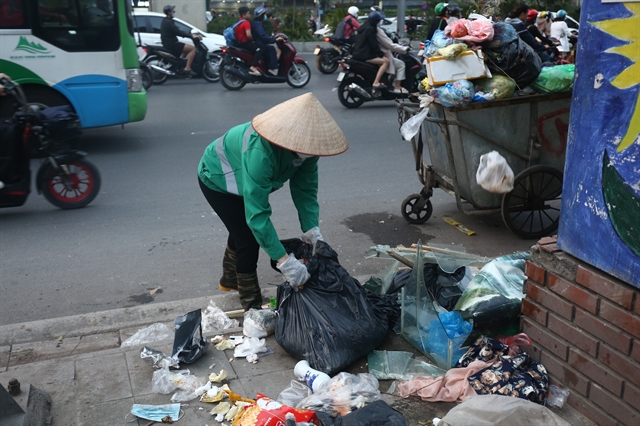 Society
Society

HCM City will need to adopt advanced energy-efficient waste-treatment technologies that safeguard the environment, and seek recycling technology to achieve a circular economy, experts said.

|
| Households in HCM City often dispose of their waste on sidewalks. VNA/VNS Photo |
HCM CITY — HCM City will need to adopt advanced energy-efficient waste-treatment technologies that safeguard the environment, and seek recycling technology to achieve a circular economy, experts said.
The city needs to ensure waste is not released directly into the environment but is handled effectively, and technology would help reduce landfill, they said.
The city discharges 9,000-9,500 tonnes of solid waste into the environment per day, incinerating, composting or recycling more than 30 per cent and dumping the rest into landfills.
It has two solid waste treatment complexes, the 614ha Đa Phước (in Bình Chánh District) and 687ha Phước Hiệp (in Củ Chi District).
Landfills require a lot of land, which puts great pressure on the city with its limited availability.
Dr Nguyễn Thanh Hùng of the HCM City Institute of Environment and Natural Resources, said the city’s solid waste volume would continue to rise due to population growth, economic development and rapid urbanisation.
Increasing the rate of recyclable waste using technology to make recycled products would help reduce the pressure on land, he said.
The city targets collecting and treating 100 per cent of domestic solid waste and having at least 80 per cent of it classified at source by 2025 and 100 per cent by 2030.
The city has invested in large waste recycling plants, including Vietstar Joint Stock Company’s solid waste treatment facility in Củ Chi District.
The facility opened in May can treat 2,000 tonnes of garbage per day using environmental friendly technology to convert it into 1,000 tonnes of useful products per month.
In addition, the Tâm Sinh Nghĩa Investment and Development Joint Stock Company has invested in a plant with a capacity of 1,000 tonnes of waste per day in Bình Tân District.
Classification at source
Hùng said the city should improve its infrastructure for collection, transport, recycling, and treatment of solid waste to ensure proper recycling.
It is also important to relocate waste recycling facilities that do not meet environmental requirements out of residential areas, he said.
The city made it mandatory to classify solid waste at source in 2018, but few households do that yet, he said.
Some do sort their waste, but everything ends up together due to the lack of specialised vehicles for various categories like recyclable and others, he said.
Experts said if all waste is classified at source and reused, the city could reduce 30 per cent of its daily waste.
Prof Dr Nguyễn Hồng Quân, director of the Institute for Circular Economy Development, said the city should encourage businesses to participate in recycling to achieve a circular economy.
“Businesses should be encouraged to switch to waste-to-energy technologies.”
It is also vital to improve people’s awareness about waste classification at source, he said.
Huỳnh Minh Nhựt, director of the HCM City Urban Environment Company Limited, said it is important to sort and collect recyclable waste at source to reduce pressure on collection and transportation to treatment facilities.
By 2025 the city plans to bury 2,600 tonnes of waste a day and recycle at least 80 per cent of domestic solid waste in urban areas to make compost or generate electricity. — VNS




